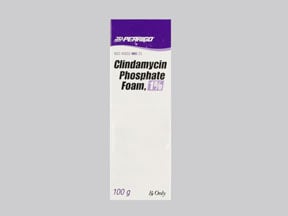
Clindacin Coupons & Savings Card – Discount Prices from $133.10
Brand for: Clindamycin phosphate
My prescription
Edit
100GM of 1%, Clindamycin Phosphate (1 Can)
Select pharmacy

CVS
$133.10
COUPON PRICE
Walgreens
$161.96
COUPON PRICE
Albertsons
$348.34
COUPON PRICE
Walmart
$379.01
COUPON PRICEFree Clindacin Savings Card

CVS
$133.10
Show this coupon to your pharmacist
ID
LH79AE180E
PCN
CHIPPO
BIN
019876
GRP
LHX
This coupon is not insurance
More prescriptions for upper respiratory infection
More prescriptions for upper respiratory infection
Price history for Clindacin (brand) & Clindamycin Phosphate (generic)
1 Can, 100GM
Average retail price for Clindacin
Average retail price for Clindamycin Phosphate
Average SaveHealth price for Clindamycin Phosphate
Our price history data is based on aggregated prescription data collected from participating pharmacies in America. Our prescription data updates daily to reflect the latest price changes. If you notice a missing data point, it means there wasn't sufficient data available to generate a monetary value for that date.
Over the last 12 months, the average discount price of Clindacin is $308.25 using the SaveHealth savings card. That's an average savings of 9.60% on Clindacin with our discount card.
*Retail prices are based on pharmacy claims data, and may not be accurate when we don't have enough claims.
Clindacin (Clindamycin Phosphate) dosage forms
Dosage Quantity Price from Per unit 100GM 1 Can $133.10 $133.10 100GM 2 Cans $248.20 $124.10 100GM 3 Cans $363.30 $121.10 100GM 4 Cans $478.40 $119.60
| Dosage | Quantity | Price from | Per unit |
|---|---|---|---|
| 100GM | 1 Can | $133.10 | $133.10 |
| 100GM | 2 Cans | $248.20 | $124.10 |
| 100GM | 3 Cans | $363.30 | $121.10 |
| 100GM | 4 Cans | $478.40 | $119.60 |
Clindacin Warnings
The following safety information outlines important considerations associated with the use of this medication. It is crucial to understand these warnings and to contact your healthcare provider if you have any questions or concerns.
Skin Irritation: Use of Clindamycin (Cleocin-T) may lead to skin issues such as redness, burning, and peeling. If these symptoms are persistent or particularly bothersome, consult your healthcare provider. The likelihood of irritation increases with the use of other skin-irritating products, existing eczema, or exposure to extreme temperatures.
Severe Diarrhea and Stomach Cramps: Although rare, Clindamycin (Cleocin-T) can increase the risk of a significant and potentially life-threatening bacterial infection. Inform your healthcare provider immediately if you experience diarrhea with bloody stools or severe stomach cramps while using this medication. Note that such symptoms can appear even weeks after discontinuing the medication, with prolonged use heightening the risk.
Sun Sensitivity: Clindamycin (Cleocin-T) may heighten your sensitivity to sunlight, increasing the risk of sunburn. It is advisable to limit sun exposure and to use a high SPF sunscreen and protective clothing, such as hats, even on cloudy days during the treatment period.
There are no specific contraindications listed for this medication. Always follow your healthcare provider's guidance for safe and effective use.
Clindacin Side Effects
When using this medication, some individuals may experience mild side effects like burning, itching, dryness, redness, peeling, or oily skin at the application site. These effects are generally not severe but should be discussed with a healthcare provider if they persist or worsen. Additionally, the skin may become more sensitive to the sun, so appropriate precautions should be taken. In rare instances, this medication can be absorbed into the bloodstream, potentially leading to a serious intestinal condition caused by the bacteria C. difficile. Symptoms of this condition include persistent diarrhea, abdominal or stomach pain, cramping, and blood or mucus in the stool. It is crucial to seek medical attention immediately if these symptoms occur and to avoid using anti-diarrhea or opioid products, as they may exacerbate the symptoms. A very serious allergic reaction to this medication is uncommon but requires immediate medical assistance. Symptoms to watch for include rash, itching or swelling, particularly of the face, tongue, or throat, severe dizziness, and difficulty breathing. Always report any side effects to your healthcare provider, especially if they are not listed here.
Clindacin Interactions
When using Clindacin, it's important to be aware of potential interactions with other medications, supplements, and certain foods, as these can affect the drug's effectiveness and safety.
Drug Interactions:
Neuromuscular Blocking Agents: Clindacin may enhance the effects of medications that relax muscles, such as atracurium, cisatracurium, and rocuronium. This can lead to prolonged muscle relaxation, so caution is advised when these drugs are used together.
Erythromycin: Combining Clindacin with erythromycin, another antibiotic, can reduce the effectiveness of both medications. Therefore, it's generally recommended to avoid using these two drugs concurrently.
Anticoagulants (Blood Thinners): Clindacin can interact with blood-thinning medications like Warfarin, potentially altering their effects and increasing the risk of bleeding. If you're taking anticoagulants, your doctor may need to monitor your blood clotting levels more closely during Clindacin therapy.
Antiepileptic Drugs: Medications such as Carbamazepine and Phenytoin may decrease the effectiveness of Clindacin by increasing its metabolism in the body.
Antifungal and Antiviral Medications: Drugs like Ketoconazole, Itraconazole, Ritonavir, and nelfinavir can increase Clindacin levels in the blood, raising the risk of side effects.
Food and Supplement Interactions:
Grapefruit Juice: Consuming grapefruit juice while taking Clindacin can increase the drug's concentration in your bloodstream, potentially leading to enhanced side effects. It's advisable to avoid grapefruit juice during your treatment.
St. John's Wort: This herbal supplement may reduce the effectiveness of Clindacin by increasing its breakdown in the body. Discuss any herbal supplements you're taking with your healthcare provider.
Vaccines:
- Oral Typhoid Vaccine: Clindacin can reduce the effectiveness of the oral typhoid vaccine. It's recommended to avoid taking Clindacin for at least three days before and after receiving this vaccine.
General Recommendations:
To minimize the risk of interactions:
Inform Your Healthcare Provider: Provide a complete list of all medications, supplements, and herbal products you're currently using.
Monitor for Side Effects: Be vigilant for any unusual symptoms or side effects and report them to your doctor promptly.
Follow Medical Advice: Always adhere to your healthcare provider's instructions regarding medication use and potential interactions.
By being proactive and informed, you can help ensure that your treatment with Clindacin is both safe and effective.
What is the use of clindacin?
Clindacin is used to treat certain types of bacterial infections. It is an antibiotic that works by stopping the growth of bacteria. It is commonly used for skin infections, respiratory infections, and infections of the internal organs.
What is the use of clindacin gel?
Clindacin gel is used topically to treat acne. It contains clindamycin, an antibiotic that helps reduce the number of acne-causing bacteria and decreases inflammation.
What is clindacin cream for?
Clindacin cream is used to treat acne. It contains clindamycin, an antibiotic that helps reduce the number of acne-causing bacteria and decreases inflammation.
What are the benefits of clindacin Gel?
Clindacin Gel, which contains clindamycin phosphate, is primarily used for the treatment of acne. The benefits include reducing the number of acne lesions, decreasing inflammation, and preventing the growth of bacteria that contribute to acne. It helps in improving the overall appearance of the skin by targeting the underlying causes of acne.
What kind of infections does clindamycin Gel treat?
Clindamycin gel is typically used to treat acne, which is caused by bacterial infections of the skin. It works by reducing the number of bacteria and decreasing inflammation, helping to clear up acne lesions.
